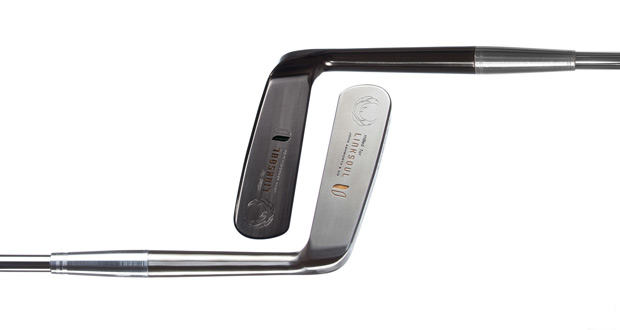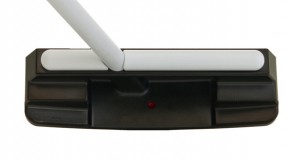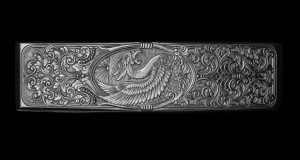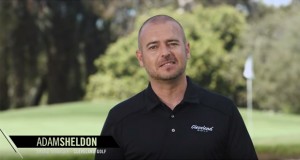We were the first outlet to tell you about Kronos putters after they launched in 2012, and now we are circling back to see what’s new and what’s next from Kronos. Since those formative days, a few things have changed, and Kronos has become a one-man show with co-founder Phillip Lapuz at the helm. We recently caught up with Phillip, here is our exclusive interview:
Tell us about your latest news and putters…
Where do I start…I have a lot of projects that I am working on. The heel-shafted Scottish Gem-like blade called the D’Arcy (pictured above) was ruled non-conforming by the USGA because the backside was considered a hitting surface. That came as shocker to me. Apparently, many old classic designs are considered non-conforming. For example the Calamity Jane is considered non-conforming by today’s rulings. Even though I think this is ridiculous, this is the world we live in. This derailed the production run of those putters. I am still going to make them just they way I had them at the PGA Show with a flat back, but I will also make a conforming one. Despite the ridiculous rule, I will say I understand why it is there and the folks at the USGA have been incredibly good about working with me.
I am also working on two new models. I am doing two long-neck putters, one left handed and one right handed. They will not be mirror images of each other. The left-handed model will only be available to left handers and a right handed version of the left-handed version will never be made by Kronos or as long as I am at the helm. I am doing this because lefties always seem to get left overs of what other designers are doing and don’t put any thought into what goes into a left-handed club. I have a small group of friends that are lefties that I am talking to to develop this putter, but one thing I noticed is they tend to make the left-handed versions of Anser style putters not very square at address. With most that I have seen, you have to forward press to square the face.
As for the right-handed long neck, it will have a bit of toe hang. I studied some CAD drawings of some other designers’ heads and again noticed all of them put the sweet spot in the wrong place. Some of them were really bad, over .25 inch off. That is terrible! I also putted with quite a few before I decided that I think a little bit of toe hang feels a lot better than a perfectly face balanced blade. I don’t have a scientific reason of why this is, but my guess is I must be prejudiced to blades having to feel the toe. This is also not a very scientific conjecture, but I think the round shape of a mallet somehow is connected with thinking it should be face balanced, so we almost expect this, so that it works.
Another fun project I am working on is using different materials. I am exploring versions of material that are actually ideal for golf and have been around in golf but companies have abandoned them because they cost too much. One of my customers told me they want me to make them a $1,000 putter, so this is what led me on this fun journey. I am looking at, of course, the usual suspects: copper, bronze, and brass for their soft feel and nice patina. However, this time, I am looking at different alloys that can give the metal a different look beyond functionality and feel. Also, I am experimenting with different polishes to bring out the different aspects of the metal. I love being in California, because we even have foundries with really great materials in our backyard!
That about sums up the putters I am working on. The other prototype that I swore you to secrecy a while back has been put on the back burner. I think it will be released someday, but I am still refining it.
You recently took a business trip to Japan. Can you tell us about that, including observations on the Japanese putter market?
My recent trip to Japan was incredible. I did a one year exchange in my undergrad and did two and a half years through the MEXT Japan Government Scholarship to get my masters in Economics. One thing I learned was how to speak Japanese, don’t ask me if I learned anything else…This came really handy in launching Kronos there. Asahi Golf is the distributor for Kronos Golf. They typically represent huge brands like Nike, Taylormade/Adidas, and Callaway among others. They also carry a lot of little things like golf tees and so on. However, their president Mr. Uchimoto has decided to try to expand their distribution into more luxurious retail stores. Kronos Golf is their pioneer brand in this field.
Two weeks before the launch of the putters they had a press conference set up to explain Kronos Golf. Kronos Golf’s creative director Eric Williams came out with me to help explain some of the concepts we are trying to express visually through photographs and videos among other visual mediums. After the press conference Asahi Golf had me tour about a dozen shops throughout Japan. This was really fun getting to know the shop managers and owners. I was emotionally moved by how passionate and knowledge these guys are about golf. I have never met so many seemingly ordinary shop owners that have so much knowledge about golf clubs. And the thing that impressed me above that was their attitude. They don’t have a know-it-all attitude. They are hungry for more knowledge and I think it is that kind of culture that has allowed them to get all the coolest golf gear in the world.
Another thing I found interesting is that I almost never got to give a sales pitch. Most shop owners looked at the putter and just said they would carry them right away. At first I was a little turned off by this, but then I listened to what they had to say. They are no fools, they know how to judge craftsmanship. After living there for 3.5 years, I feel I have a little bit of a feel for the culture and I was still very impressed. I am going to take a stab at why I think they are so incredibly knowledgeable about these types of things. I think it is ingrained in their culture to appreciate and value craftsmanship. The Japanese still value art. You can find hand-made pottery in department stores that are meant for daily use. They also value folk art. Art that is coming from the people. Local art! Sorry I went off on a tangent there, but I really think that is one factor that adds to this huge knowledge base.
It takes courage to start a golf equipment company. Can you describe your experience as a young entrepreneur breaking into the putter market? What has surprised you?
The phrase I always here is “it must be hard in this economy.” I think there is never going to be an easy time to start anything. Starting a golf equipment company is extremely hard but also so rewarding. It is hard for so many reasons but a few reasons are: (1) because it is just hard to make something; (2) because it is hard to sell new things; (3) because of the emotional roller coaster from being constantly blindsided. The rewarding part is seeing your vision, your dreams, become to life.
Breaking into the putter market is not easy. But let me dissect the question a little bit. If we define breaking into a market by making a product, then I think it is relatively easy. Most people think making a product is the hard part. They got it wrong, that is the fun part. The hard part is getting people to understand your product. Before I came out with my first design, the Touch, I found myself complaining about one putter being too hard, one putter making the wrong sound, this putter having poor craftsmanship, that putter being unbalanced, and so on. Instead of complaining, I decided I should do something about it. I made a list of little but important things that I would change to make my dream putter. One with incredible feel, feedback, that has clearly defined edges so I know where the face is lined up, that has the sight line right where the sweet spot is, where the look shows subtle natural beauty in the metal and machining, and so on.
So I guess part of breaking into the market was filling a need or fixing a problem that I was dealing with and thinking from there that others might feel the same way. The confusing and scary part is when you start to get mixed reviews. You start to question yourself on everything. So far I think the other designers have been very nice and respectful. I will say I have met a lot sleazeballs too. But overall very good. One thing I am afraid of is when the other designers start running out of ideas and they start to copy some of the things I have worked so hard at to differentiate my products. I think this industry is very incestuous. The golf industry is very small and everybody knows everybody. Being in the industry, I get to see a lot of stuff before it comes out. If I see something another designer is doing, I make note that I should stay clear of that because this see-one-do-one mentality is killing the industry and I hate it. I spend a lot of time with my friends in other industries and with different backgrounds and try to draw some ideas from them.
The thing that surprises me is that the surprises never stop. The surprises come in all forms good and bad. It seems like there is just one fire after the next to put out. It isn’t exactly fun but it is rewarding. This is going to sound really lame, but I think golfers make really good entrepreneurs. There are so many external uncontrollable and unknown factors in golf that sometimes the best thing to do is just control the few factors that you can. As for being an entrepreneur, it is the same way with so many external factors, but the only factors we can control is our emotions and our attitude.
What is next for Kronos?
This year Kronos is going to make an effort to support some tour players on various levels. I am still working on getting tour credentials for Kronos, but I think I will be able to get them in time for some of the California events. I am also thinking of going abroad to Europe to help with distribution there and also work on some new products over there. My current distributor in Scotland owns a machine shop and we think it would be cool to run a very limited number of putters out of his shop. I also have some ideas to make some accessories to complement the putters in Italy. I have an Italian friend out there that is like brother to me we are talking about making some ultra premium items. It will be fun and silly like the $1,000 putter project!
Thanks, Philip!
 PutterZone – Best Putter Reviews
PutterZone – Best Putter Reviews




